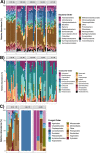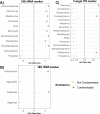Soil Microbial Community Composition and Tolerance to Contaminants in an Urban Brownfield Site
- PMID: 35802172
- PMCID: PMC10156844
- DOI: 10.1007/s00248-022-02061-1
Soil Microbial Community Composition and Tolerance to Contaminants in an Urban Brownfield Site
Abstract
Brownfields are unused sites that contain hazardous substances due to previous commercial or industrial use. The sites are inhospitable for many organisms, but some fungi and microbes can tolerate and thrive in the nutrient-depleted and contaminated soils. However, few studies have characterized the impacts of long-term contamination on soil microbiome composition and diversity at brownfields. This study focuses on an urban brownfield-a former rail yard in Los Angeles that is contaminated with heavy metals, volatile organic compounds, and petroleum-derived pollutants. We anticipate that heavy metals and organic pollutants will shape soil microbiome diversity and that several candidate fungi and bacteria will be tolerant to the contaminants. We sequence three gene markers (16S ribosomal RNA, 18S ribosomal RNA, and the fungal internal transcribed spacer (FITS)) in 55 soil samples collected at five depths to (1) profile the composition of the soil microbiome across depths; (2) determine the extent to which hazardous chemicals predict microbiome variation; and (3) identify microbial taxonomic groups that may metabolize these contaminants. Detected contaminants in the samples included heavy metals, petroleum hydrocarbons, polycyclic aromatic hydrocarbons, and volatile organic compounds. Bacterial, eukaryotic, and fungal communities all varied with depth and with concentrations of arsenic, chromium, cobalt, and lead. 18S rRNA microbiome richness and fungal richness were positively correlated with lead and cobalt levels, respectively. Furthermore, bacterial Paenibacillus and Iamia, eukaryotic Actinochloris, and fungal Alternaria were enriched in contaminated soils compared to uncontaminated soils and represent taxa of interest for future bioremediation research. Based on our results, we recommend incorporating DNA-based multi-marker microbial community profiling at multiple sites and depths in brownfield site assessment standard methods and restoration.
Keywords: 16S rRNA; 18S rRNA; Brownfields; Contamination; Heavy metals; ITS; Soil microbiome; eDNA.
© 2022. The Author(s).
Figures





Similar articles
-
Effects of co-contamination of heavy metals and total petroleum hydrocarbons on soil bacterial community and function network reconstitution.Ecotoxicol Environ Saf. 2020 Nov;204:111083. doi: 10.1016/j.ecoenv.2020.111083. Epub 2020 Aug 10. Ecotoxicol Environ Saf. 2020. PMID: 32791359
-
Implications of co-contamination with aged heavy metals and total petroleum hydrocarbons on natural attenuation and ecotoxicity in Australian soils.Environ Pollut. 2018 Dec;243(Pt A):94-102. doi: 10.1016/j.envpol.2018.08.040. Epub 2018 Aug 18. Environ Pollut. 2018. PMID: 30172128
-
Petroleum contamination significantly changes soil microbial communities in three oilfield locations in Delta State, Nigeria.Environ Sci Pollut Res Int. 2021 Jun;28(24):31447-31461. doi: 10.1007/s11356-021-12955-1. Epub 2021 Feb 19. Environ Sci Pollut Res Int. 2021. PMID: 33604834
-
Functional microbiome strategies for the bioremediation of petroleum-hydrocarbon and heavy metal contaminated soils: A review.Sci Total Environ. 2022 Aug 10;833:155222. doi: 10.1016/j.scitotenv.2022.155222. Epub 2022 Apr 11. Sci Total Environ. 2022. PMID: 35421499 Review.
-
Bioremediation of soils contaminated with polycyclic aromatic hydrocarbons, petroleum, pesticides, chlorophenols and heavy metals by composting: Applications, microbes and future research needs.Biotechnol Adv. 2015 Nov 1;33(6 Pt 1):745-55. doi: 10.1016/j.biotechadv.2015.05.003. Epub 2015 May 22. Biotechnol Adv. 2015. PMID: 26008965 Review.
Cited by
-
Distribution patterns of soil bacteria, fungi, and protists emerge from distinct assembly processes across subcommunities.Ecol Evol. 2024 Jul 10;14(7):e11672. doi: 10.1002/ece3.11672. eCollection 2024 Jul. Ecol Evol. 2024. PMID: 38988351 Free PMC article.
-
Potassium humate and cobalt enhance peanut tolerance to water stress through regulation of proline, antioxidants, and maintenance of nutrient homeostasis.Sci Rep. 2024 Jan 18;14(1):1625. doi: 10.1038/s41598-023-50714-z. Sci Rep. 2024. PMID: 38238388 Free PMC article.
-
Exploring the Ecological Impacts of Herbicides on Antibiotic Resistance Genes and Microbial Communities.Life (Basel). 2025 Mar 26;15(4):547. doi: 10.3390/life15040547. Life (Basel). 2025. PMID: 40283102 Free PMC article.
-
Assessment of potential dominant factors for brownfield landscape regeneration: A case study in Xi'an, China.PLoS One. 2025 Feb 10;20(2):e0312668. doi: 10.1371/journal.pone.0312668. eCollection 2025. PLoS One. 2025. PMID: 39928680 Free PMC article.
References
-
- US EPA O (2014) Overview of EPA’s Brownfields Program. In: US EPA. https://www.epa.gov/brownfields/overview-epas-brownfields-program. Accessed 28 May 2021
-
- Jones P, Comfort D (2021) Ecosystem services and brownfield land. Town and Country Planning 90:344–348. https://eprints.glos.ac.uk/id/eprint/10343
-
- Kolosz BW, Athanasiadis IN, Cadisch G, et al. Conceptual advancement of socio-ecological modelling of ecosystem services for re-evaluating brownfield land. Ecosyst Serv. 2018;33:29–39. doi: 10.1016/j.ecoser.2018.08.003. - DOI
MeSH terms
Substances
Grants and funding
LinkOut - more resources
Full Text Sources

